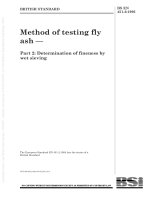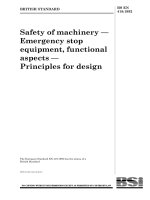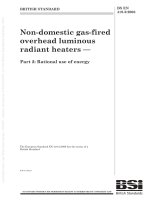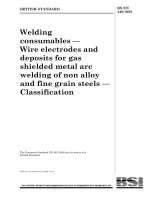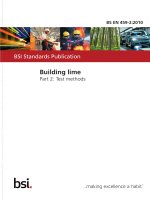Bsi bs en 00866 2 1998
Bạn đang xem bản rút gọn của tài liệu. Xem và tải ngay bản đầy đủ của tài liệu tại đây (135.02 KB, 12 trang )
BRITISH STANDARD
Biological systems for testing
sterilizers and sterilization
processes
Part 2. Particular systems for use in
ethylene oxide sterilizers
The European Standard EN 866-2 : 1997 has the status of a
British Standard
ICS 11.080
NO COPYING WITHOUT BSI PERMISSION EXCEPT AS PERMITTED BY COPYRIGHT LAW
|
|
|
|
|
|
|
|
|
|
|
|
|
|
|
|
|
|
|
|
|
|
|
|
|
|
|
|
|
|
|
|
|
|
|
|
|
|
|
|
|
|
|
|
|
|
|
|
|
|
|
|
|
|
|
|
|
|
|
|
|
|
|
|
|
|
|
|
|
|
|
|
|
|
|
|
|
|
|
|
|
|
|
|
|
|
|
|
|
|
|
|
|
|
|
|
|
|
|
|
|
|
|
|
|
|
|
|
|
|
|
|
|
|
|
|
|
|
|
|
|
|
|
|
|
|
|
|
|
BS EN
866-2 : 1998
BS EN 866-2 : 1998
Committees responsible for this
British Standard
The preparation of this British Standard was entrusted by Technical Committee
LBI/35, Sterilizers, autoclaves and disinfectors, to Subcommittee LBI/35/3,
Sterilization indicators, upon which the following bodies were represented:
ABHI Special Interest Section (Sterilizers and Disinfectors)
Association of British Healthcare Industries
BLWA Ltd (the Association of the Laboratory Supply Industry)
Department of Health (Medical Devices Agency)
European Sterilization Packaging Association (UK)
Medical Sterile Products Association
Public Health Laboratory Service
Royal College of Pathologists
Royal Pharmaceutical Society of Great Britain
This British Standard, having
been prepared under the
direction of the Sector Board for
Materials and Chemicals, was
published under the authority of
the Standards Board and comes
into effect on 15 March 1998
BSI 1998
Amendments issued since publication
Amd. No.
The following BSI references
relate to the work on this
standard:
Committee reference LBI/35/3
Draft for comment 95/121172 DC
ISBN 0 580 28378 X
Date
Text affected
BS EN 866-2 : 1998
National foreword
This Part of BS EN 866 has been prepared by Subcommittee LBI/35/3 and is the
English language version of EN 866-2 : 1997 Biological systems for testing sterilizers
and sterilization processes Ð Part 2: Particular systems for use in ethylene oxide
sterilizers, published by the European Committee for Standardization (CEN).
Cross-reference
Publication referred to
Corresponding British Standard
EN 866-1 : 1997
BS EN 866 Biological systems for testing sterilizers and
sterilization processes
Part 1 : 1997 General requirements
Compliance with a British Standard does not of itself confer immunity
from legal obligations.
Summary of pages
This document comprises a front cover, an inside front cover, pages i and ii,
the EN title page, pages 2 to 6, an inside back cover and a back cover.
BSI 1998
i
ii
blank
EN 866-2
EUROPEAN STANDARD
NORME EUROPÊENNE
EUROPẰISCHE NORM
February 1997
ICS 11.080
Descriptors: Medical equipment, sterilizers, sterilization, ethylene oxide, bioassay, specifications, biological indicators
English version
Biological systems for testing sterilizers and sterilization
processes Ð Part 2: Particular systems for use in
ethylene oxide sterilizers
SysteÁmes biologiques pour l'essai des steÂrilisateurs
et les proceÂdeÂs de steÂrilisation Ð Partie 2: SysteÁmes
particuliers destineÂs aÁ eÃtre utiliseÂs dans des
steÂrilisateurs aÁ l'oxyde d'eÂthyleÁne
Biologische Systeme fuÈr die PruÈfung von
Sterilisatoren und Sterilisationsverfahren Ð
Teil 2: Spezielle Systeme fuÈr den Gebrauch in
Ethylenoxid-Sterilisatoren
www.bzfxw.com
This European Standard was approved by CEN on 1997-01-10. CEN members are
bound to comply with the CEN/CENELEC Internal Regulations which stipulate the
conditions for giving this European Standard the status of a national standard
without any alteration.
Up-to-date lists and bibliographical references concerning such national standards
may be obtained on application to the Central Secretariat or to any CEN member.
This European Standard exists in three official versions (English, French, German).
A version in any other language made by translation under the responsibility of a
CEN member into its own language and notified to the Central Secretariat has the
same status as the official versions.
CEN members are the national standards bodies of Austria, Belgium, Denmark,
Finland, France, Germany, Greece, Iceland, Ireland, Italy, Luxembourg, Netherlands,
Norway, Portugal, Spain, Sweden, Switzerland and United Kingdom.
CEN
European Committee for Standardization
Comite EuropeÂen de Normalisation
EuropaÈisches Komitee fuÈr Normung
Central Secretariat: rue de Stassart 36, B-1050 Brussels
1997 Copyright reserved to CEN members.
Ref. No. EN 866-2 : 1997 E
Page 2
EN 866-2 : 1997
Foreword
This European Standard has been prepared by
Technical Committee CEN/TC 102, Sterilizers for
medical purposes, the secretariat of which is held by
DIN.
This Standard is one of a series of European Standards
concerned with biological systems for testing
sterilizers. These European Standards are:
EN 866-1
Biological systems for testing sterilizers
and sterilization processes Ð
Part 1: General requirements
EN 866-2
Biological systems for testing sterilizers
and sterilization processes Ð
Part 2: Particular systems for use in
ethylene oxide sterilizers
EN 866-3
Biological systems for testing sterilizers
and sterilization processes Ð
Part 3: Particular systems for use in
moist heat sterilizers
prEN 866-4 Biological systems for testing sterilizers
and sterilization processes Ð
Part 4: Particular systems for use in
irradiation sterilizers
prEN 866-5 Biological systems for testing sterilizers
and sterilization processes Ð
Part 5: Particular systems for use in low
temperature steam and formaldehyde
sterilizers
prEN 866-6 Biological systems for testing sterilizers
and sterilization processes Ð
Part 6: Particular systems for use in dry
heat sterilizers
prEN 866-7 Biological systems for testing sterilizers
and sterilization processes Ð
Part 7: Particular requirements for
self-contained biological indicator
systems for use in moist heat sterilizers
prEN 866-8 Biological systems for testing sterilizers
and sterilization processes Ð
Part 8: Particular requirements for
self-contained biological indicator
systems for use in ethylene oxide
sterilizers
In addition, CEN/TC 102 Working Group 7 has prepared
a series of European Standards describing
non-biological indicators for use in sterilizers. These
European Standards are:
EN 867-1
Non-biological systems for use in
sterilizers Ð
Part 1: General requirements
EN 867-2
Non-biological systems for use in
sterilizers Ð
Part 2: Process indicators (Class A)
EN 867-3
Non-biological systems for use in
sterilizers Ð
Part 3: Specification for Class B
indicators for use in the Bowie and
Dick test
This European Standard shall be given the status of a
national standard, either by publication of an identical
text or by endorsement, at the latest by August 1997,
and conflicting national standards shall be withdrawn
at the latest by August 1997.
This European Standard has been prepared under a
mandate given to CEN by the European Commission
and the European Free Trade Association, and
supports essential requirements of EU Directive(s).
According to the CEN/CENELEC Internal Regulations,
the national standards organizations of the following
countries are bound to implement this European
Standard: Austria, Belgium, Denmark, Finland, France,
Germany, Greece, Iceland, Ireland, Italy, Luxembourg,
Netherlands, Norway, Portugal, Spain, Sweden,
Switzerland and the United Kingdom.
www.bzfxw.com
Contents
Foreword
Introduction
1
Scope
2
Normative references
3
Definitions
4
General requirements
5
Test organisms
6
Population of test organisms
7
Carriers
8
Resistance
Annexes
A
(normative) Method for the
determination of resistance to
ethylene oxide sterilization
B
(informative) Bibliography
Page
2
3
3
3
3
3
3
3
4
4
5
6
BSI 1998
Page 3
EN 866-2 : 1997
Introduction
2 Normative references
This standard specifies the performance requirements
for biological indicators supplied ready for use, and for
suspensions of test organisms supplied either for the
preparation of biological indicators or for the
inoculation of product for use in validation studies on,
and routine monitoring of, ethylene oxide sterilization
processes. The use of the indicators specified in this
standard is described in EN 550.
The biological indicators specified in this standard are
not intended for use in any process other than
ethylene oxide sterilization. The use of an
inappropriate biological indicator in a process other
than that stated by the manufacturer can give
dangerously misleading results.
The use of a biological system for testing a sterilization
process does not allow necessarily the same level of
sensitivity in response to inadequate levels of all the
critical variables of the process.
The performance of a biological indicator can be
affected by the conditions of storage prior to use, the
methods of use, and the techniques employed after
exposure to the process. For these reasons, the
recommendations of the manufacturer for storage and
use should be followed and biological indicators
should be transferred to the specified recovery
conditions as soon as possible after exposure to the
process. Biological indicators should not be used
beyond any expiry date stated by the manufacturer.
Biological indicators should always be used in
combination with physical and/or chemical monitoring
in demonstrating the efficacy of a sterilization process.
When a physico-chemical variable of a sterilization
process is outside its specified limits, a sterilization
cycle should always be regarded as unsatisfactory,
irrespective of the results obtained from the biological
indicators. (See also EN 550).
This European Standard incorporates by dated or
undated references provisions from other publications.
These normative references are cited at the
appropriate places in the text and the publications are
listed hereafter. For dated references, subsequent
amendments to or revisions of any of these
publications apply to this European Standard only
when incorporated in it by amendment or revision. For
undated references the latest edition of the publication
referred to applies.
EN 866-1 : 1997 Biological systems for testing
sterilizers and sterilization
processes Ð Part 1: General
requirements
3 Definitions
For the purposes of this standard, the definitions given
in EN 866-1 apply.
4 General requirements
The requirements of EN 866-1 shall apply.
www.bzfxw.com
1 Scope
This Part of EN 866 specifies requirements for
inoculated carriers and biological indicators intended
for use in assessing the performance of sterilizers and
sterilization processes employing ethylene oxide gas as
the sterilant. These are intended for use in sterilizers
employing pure ethylene oxide gas or admixtures of
the gas with diluent gases, over a sterilizing
temperature range of 20 8C to 65 8C.
NOTE. prEN 1422 specifies the performance and test requirements
for ethylene oxide sterilizers. EN 550 specifies the requirements
for the validation and routine monitoring of ethylene oxide
sterilization.
BSI 1998
5 Test organisms
The test organism shall be spores of Bacillus subtilis
var. niger or other strains or organisms of
demonstrated equivalent performance as required by
this standard.
NOTE. Bacillus subtilis NCTC 10073, DSM 2277, ATCC 9372 or
CIP 7718 have been found to be suitable.
6 Population of test organisms
6.1 Replicate determinations of the viable count on
the same batch of suspension shall be within ± 35 % of
the nominal population.
6.2 The number of recoverable test organisms on
each biological indicator shall be controlled during
manufacture to be either within ± 50 % of the nominal
population stated by the manufacturer, or within the
minimum and maximum populations stated by the
manufacturer.
Page 4
EN 866-2 : 1997
6.3 Retrospective determination of the count shall be
made by performing a viable count under the culture
conditions on a suspension of test organisms obtained
by physical removal of the test organisms from the
carrier through ultrasonication, shaking with glass
beads, or other appropriate validated methods. Counts
obtained shall be regarded as acceptable if they are
within 250 % and +300 % of the nominal population
stated by the manufacturer or the mid-point between
the minimum and maximum populations stated by the
manufacturer.
NOTE. Guidance on the selection and validation of methods for
the removal of micro-organisms from the carrier is given in
EN 1174-2.
6.4 For inoculated carriers or biological indicators
intended for use in routine monitoring, the nominal
number of spores shall be not less than 1 3 106 per
unit and shall be stated in increments not greater than
0,1 3 106.
NOTE. Inoculated carriers and/or biological indicators supplied for
other purposes, e.g. qualification, validation and other specific
tests, may require other nominal populations.
7 Carriers
7.1 The suitability of the carrier for use in ethylene
oxide sterilization processes shall be demonstrated in
accordance with the requirements of 6.1 and 6.2 of
EN 866-1 : 1997 and annex A of this standard.
7.2 The exposure conditions to be used to establish
compliance shall be:
± temperature: not less than 55 8C;
± relative humidity: not less than 70 %;
± gas concentration: not less than 800 mg/l;
± exposure time: not less than 6 h.
NOTE. These conditions have been selected to represent a
realistic challenge to the carrier whilst remaining within the
practical limits of an ethylene oxide sterilization process.
8 Resistance
8.1 General
The manufacturer shall state the D value of each batch
of biological indicators or inoculated carriers to an
accuracy of ± 0,5 min.
8.2 Biological indicators and inoculated
carriers intended for use in routine monitoring
8.2.1 The D values obtained for the spore population
on the inoculated carriers shall be not less than
12,5 min when exposed to (600 ± 30) mg/l ethylene
oxide at (30 ± 1) 8C and (60 ± 10) % relative humidity,
and/or not less than 2,5 min when exposed to
(600 ± 30) mg/l ethylene oxide at (54 ± 1) 8C and
(60 ± 10) % relative humidity, determined in accordance
with the method given in annex A. (See 10.2 of
EN 866-1 : 1997).
NOTE. A temperature coefficient of inactivation of the test
organism of not less than 2 can be used to relate these D values
to other temperatures when all other conditions remain constant.
8.2.2 The D value obtained by the two methods shall
be such that the higher value obtained does not exceed
the lower value by more than 50 % of the lower value.
8.3 Biological indicators and inoculated
carriers intended for use in validation,
qualification and other specific tests
www.bzfxw.com
NOTE. Biological indicators and inoculated carriers intended for
use in validation, qualification and other specific tests have no
specific requirements for the population or resistance of test
organisms, to allow users flexibility in devising test programs.
The D value and population are determined and stated (see 6.3
and 6.4, 8.1, 8.3a, 8.3b).
When the purchaser specifies requirements other than
those in 8.2 for biological indicators and inoculated
carriers intended for use in validation, qualification and
other specific tests, the following shall apply.
a) The D values shall be determined by exposure to
(600 ± 30) mg/l ethylene oxide at (30 ± 1) 8C and
(60 ± 10) % relative humidity, and by exposure to
(600 ± 30) mg/l ethylene oxide at (54 ± 1) 8C and
(60 ± 10) % relative humidity, in accordance with the
methods given in annex A.
b) The D value obtained shall be such that the
higher value obtained does not exceed the lower
value by more than 50 % of the lower value. Both D
values shall be stated.
BSI 1998
Page 5
EN 866-2 : 1997
Annex A (normative)
Method for the determination of
resistance to ethylene oxide sterilization
A.1 Apparatus: Ethylene oxide biological
indicator resistometer
A.1.1 The equipment shall be capable of maintaining
the conditions given in table A.1, within the limits
given, for exposure periods of between 1 min and
120 min to an accuracy of ± 10 s. In addition, the
equipment shall be capable of sustaining an exposure
of not less than 6 h.
Table A.1 Conditions
Variable
For resistance
studies
(see clause 8)
For carrier studies
(see clause 7)
Ethylene oxide (600 ± 30) mg/l Not less than
800 mg/l
Temperature
(30 ± 1) 8C or Not less than 55 8C
(54 ± 1) 8C
Relative
(60 ± 10) %
Not less than 70 %
humidity
A.1.6 The equipment shall be capable of automatic
operation and shall be provided with a system for
recording temperature, pressure and humidity within
the chamber, this system being independent of the
control function and such that the limits of error on
the recording equipment do not exceed 50 % of the
tolerance allowed for each control variable.
For example, the chamber temperature shall be
required to be controlled within ± 1 K, and thus the
maximum allowable error limit on the temperature
recorder is ± 0,5 K.
A.1.7 At the end of the exposure period, the pressure
in the resistometer chamber shall be reduced to 10 kPa
or less in a period not exceeding 1 min, and the
chamber shall return to ambient pressure in not more
than 20 s.
A.1.8 The resistometer shall be provided with test
connections.
NOTE. Suitable test connections are described in prEN 1422.
A.2 Procedure
A.2.1 Operation of the resistometer
A.2.1.1 Preheat the resistometer chamber to the
chosen operating temperature.
www.bzfxw.com
NOTE 1. Forced circulation may be required to maintain the
conditions in the resistometer chamber uniform within the
specified limits.
A.2.1.2 Load the inoculated carriers onto a suitable
sample holder.
NOTE 2. Resistometers intended for use with mixtures of
ethylene oxide and inert gases may be required to withstand
high internal pressures, e.g. 650 kPa.
A.2.1.3 Place the loaded sample holder in the
chamber, close the chamber and initiate the test cycle.
A.1.2 The equipment shall be provided with means to
evacuate the reaction chamber to less than 10 kPa
within 2 min, to permit adequate air removal prior to
admission of the sterilant and to exhaust the sterilant
at the end of the exposure period. Air admitted at the
end of the cycle shall be filtered through a filter having
the ability to remove not less than 99,9 % of 0,5 mm
particles.
A.1.3 The time to achieve the required gas
concentration from commencement of gas admission
shall not exceed 60 s, and the time to exhaust the gas
to 10 kPa at the end of the exposure period shall not
exceed 60 s.
A.1.4 The chamber and door shall be provided with
means to maintain the temperature of the inner
surfaces of the chamber at the required operating
temperature.
A.1.5 The supply of ethylene oxide gas to the
chamber shall be filtered, evaporated to gas phase and
preheated to ensure that neither liquid ethylene oxide
nor particles of polymer are admitted to the chamber.
BSI 1998
A.2.1.4 Carry out the following sequence of
operations under automatic control.
a) Evacuate the chamber to (10 ± 0,4) kPa.
b) Admit sufficient water vapour to raise the relative
humidity in the chamber to (60 ± 10) % and maintain
these conditions for a period of 28 min to 30 min
(see prEN 1422, sterilization cycle stage 3:
conditioning stage).
c) Admit ethylene oxide to the chamber to obtain a
concentration of (600 ± 30) mg/l within 60 s.
d) For the 0 min exposure time, no ethylene oxide
shall be admitted.
e) Maintain these conditions for the required
exposure period.
f) At the end of the exposure period, evacuate the
chamber to (10 ± 0,4) kPa within 60 s and then admit
filtered air, or an inert gas such as nitrogen, to
ambient pressure.
g) Repeat stage f) a further four times.
A.2.1.5 At the end of the above cycle, remove the
sample holder from the chamber within 30 s of the
completion of the cycle.
Page 6
EN 866-2 : 1997
A.2.2 Survivor curve method for determination of
D value
A.2.2.1 As soon as possible, but in any case within
2 h, transfer the exposed inoculated carrier into sterile
distilled water. Physically remove the spores from the
carriers into sterile distilled water by ultrasonication.
Record the time taken to complete the transfer.
A.2.2.2 Determine the viable count of the suspension
obtained, using the recovery medium and conditions
stated by the manufacturer.
A.2.3 Most-probable-number method for
determination of D value
Annex B (informative)
Bibliography
EN 550
prEN 1422
EN 1174-2
Sterilization of medical devices Ð
Validation and routine control of
ethylene oxide sterilization
Sterilizers for medical purposes Ð
Ethylene oxide sterilizers Ð
Specification
Medical devices Ð Estimation of the
population of micro-organisms on
product Ð Part 2: Guidance
A.2.3.1 As soon as possible, but in any case within
2 h, aseptically transfer each inoculated carrier into a
container of recovery medium. Record the time taken
to complete the transfer.
A.2.3.2 Use the recovery medium stated by the
manufacturer and incubate in accordance with the
manufacturer's instructions.
A.3 Determination of resistance
Determine the resistance by both the survivor curve
method and the MPN method. (See annex B of
EN 866-1 : 1997).
www.bzfxw.com
BSI 1998
BS EN 866-2 : 1998
List of references
See national foreword.
BSI 1998
BSI
389 Chiswick High Road
London
W4 4AL
|
|
|
|
|
|
|
|
|
|
|
|
|
|
|
|
|
|
|
|
|
|
|
|
|
|
|
|
|
|
|
|
|
|
|
|
|
|
|
|
|
|
|
|
|
|
|
|
|
|
|
|
|
|
|
|
|
|
|
|
|
|
|
|
|
|
|
|
|
|
|
|
|
|
|
|
|
|
|
|
|
|
|
|
|
|
|
|
|
|
|
|
|
|
|
|
|
|
|
|
|
|
|
|
|
|
|
|
|
|
|
|
|
|
|
|
|
|
|
|
|
|
|
|
|
|
|
BSI Ð British Standards Institution
BSI is the independent national body responsible for preparing British Standards. It
presents the UK view on standards in Europe and at the international level. It is
incorporated by Royal Charter.
Revisions
British Standards are updated by amendment or revision. Users of British Standards
should make sure that they possess the latest amendments or editions.
It is the constant aim of BSI to improve the quality of our products and services. We
would be grateful if anyone finding an inaccuracy or ambiguity while using this
British Standard would inform the Secretary of the technical committee responsible,
the identity of which can be found on the inside front cover. Tel: 020 8996 9000.
Fax: 020 8996 7400.
BSI offers members an individual updating service called PLUS which ensures that
subscribers automatically receive the latest editions of standards.
Buying standards
Orders for all BSI, international and foreign standards publications should be
addressed to Customer Services. Tel: 020 8996 9001. Fax: 020 8996 7001.
In response to orders for international standards, it is BSI policy to supply the BSI
implementation of those that have been published as British Standards, unless
otherwise requested.
Information on standards
BSI provides a wide range of information on national, European and international
standards through its Library and its Technical Help to Exporters Service. Various
BSI electronic information services are also available which give details on all its
products and services. Contact the Information Centre. Tel: 020 8996 7111.
Fax: 020 8996 7048.
Subscribing members of BSI are kept up to date with standards developments and
receive substantial discounts on the purchase price of standards. For details of
these and other benefits contact Membership Administration. Tel: 020 8996 7002.
Fax: 020 8996 7001.
Copyright
Copyright subsists in all BSI publications. BSI also holds the copyright, in the UK, of
the publications of the international standardization bodies. Except as permitted
under the Copyright, Designs and Patents Act 1988 no extract may be reproduced,
stored in a retrieval system or transmitted in any form or by any means ± electronic,
photocopying, recording or otherwise ± without prior written permission from BSI.
This does not preclude the free use, in the course of implementing the standard, of
necessary details such as symbols, and size, type or grade designations. If these
details are to be used for any other purpose than implementation then the prior
written permission of BSI must be obtained.
If permission is granted, the terms may include royalty payments or a licensing
agreement. Details and advice can be obtained from the Copyright Manager.
Tel: 020 8996 7070.

